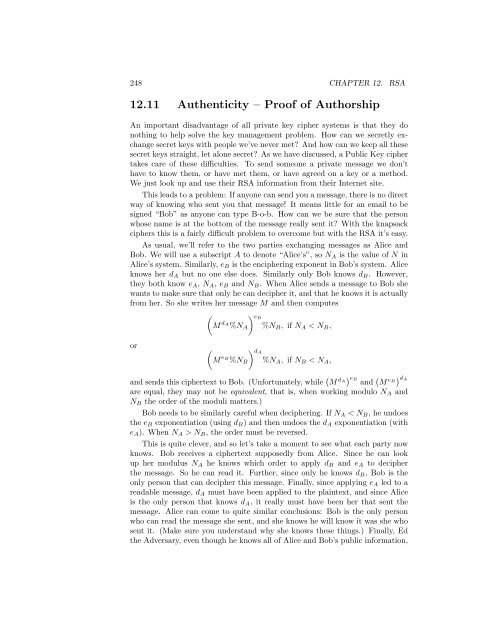Cryptology - Unofficial St. Mary's College of California Web Site
Cryptology - Unofficial St. Mary's College of California Web Site
Cryptology - Unofficial St. Mary's College of California Web Site
You also want an ePaper? Increase the reach of your titles
YUMPU automatically turns print PDFs into web optimized ePapers that Google loves.
248 CHAPTER 12. RSA<br />
12.11 Authenticity – Pro<strong>of</strong> <strong>of</strong> Authorship<br />
An important disadvantage <strong>of</strong> all private key cipher systems is that they do<br />
nothing to help solve the key management problem. How can we secretly exchange<br />
secret keys with people we’ve never met And how can we keep all these<br />
secret keys straight, let alone secret As we have discussed, a Public Key cipher<br />
takes care <strong>of</strong> these difficulties. To send someone a private message we don’t<br />
have to know them, or have met them, or have agreed on a key or a method.<br />
We just look up and use their RSA information from their Internet site.<br />
This leads to a problem: If anyone can send you a message, there is no direct<br />
way <strong>of</strong> knowing who sent you that message! It means little for an email to be<br />
signed “Bob” as anyone can type B-o-b. How can we be sure that the person<br />
whose name is at the bottom <strong>of</strong> the message really sent it With the knapsack<br />
ciphers this is a fairly difficult problem to overcome but with the RSA it’s easy.<br />
As usual, we’ll refer to the two parties exchanging messages as Alice and<br />
Bob. We will use a subscript A to denote “Alice’s”, so N A is the value <strong>of</strong> N in<br />
Alice’s system. Similarly, e B is the enciphering exponent in Bob’s system. Alice<br />
knows her d A but no one else does. Similarly only Bob knows d B . However,<br />
they both know e A , N A , e B and N B . When Alice sends a message to Bob she<br />
wants to make sure that only he can decipher it, and that he knows it is actually<br />
from her. So she writes her message M and then computes<br />
(<br />
M d A<br />
%N A<br />
) eB<br />
%N B , if N A < N B ,<br />
or (<br />
M e B<br />
%N B<br />
) dA<br />
%N A , if N B < N A ,<br />
and sends this ciphertext to Bob. (Unfortunately, while ( )<br />
M d eB<br />
( )<br />
A and M<br />
e dA B<br />
are equal, they may not be equivalent, that is, when working modulo N A and<br />
N B the order <strong>of</strong> the moduli matters.)<br />
Bob needs to be similarly careful when deciphering. If N A < N B , he undoes<br />
the e B exponentiation (using d B ) and then undoes the d A exponentiation (with<br />
e A ). When N A > N B , the order must be reversed.<br />
This is quite clever, and so let’s take a moment to see what each party now<br />
knows. Bob receives a ciphertext supposedly from Alice. Since he can look<br />
up her modulus N A he knows which order to apply d B and e A to decipher<br />
the message. So he can read it. Further, since only he knows d B , Bob is the<br />
only person that can decipher this message. Finally, since applying e A led to a<br />
readable message, d A must have been applied to the plaintext, and since Alice<br />
is the only person that knows d A , it really must have been her that sent the<br />
message. Alice can come to quite similar conclusions: Bob is the only person<br />
who can read the message she sent, and she knows he will know it was she who<br />
sent it. (Make sure you understand why she knows these things.) Finally, Ed<br />
the Adversary, even though he knows all <strong>of</strong> Alice and Bob’s public information,

















